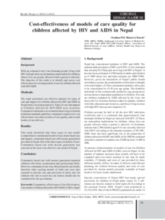This research study aimed to identify and assess the cost effectiveness for existing models of care for Children Affected by HIV and AIDS (CABA) in Nepal (defined as children under 15 for the purpose of this study). The study performed a cost effective analysis for types of care and support models available for CABAs in order to provide program mangers and childcare professionals comparative economic evidence of the cost of caring for these children. Comparative analysis for cost effectiveness was done in terms of quality and overall modes of care delivery, using government minimum standards guidelines as a framework.
The study consisted of two phases: 1) assessment for types of care and support to CABA; and 2) comparison of variations in cost for different approaches and options. In the first phase, the study found that the government of Nepal prepared a final draft, “Minimum standards working guidelines for HIV/ADIS infected child care homes, 2009,” which was a resourceful document in identifying essential care elements. It also used interviews with childcare professionals and literature reviews to identify existing types of care for CABAs in the country. Phase two calculated the economic costs for care quality in institutions through cost effectiveness analysis, which identifies types of services that are more likely to be beneficial given that they are provided with necessary resources.
Community-based childcare model, home-based care, and comprehensive care model were identified as the three types of care for CABAs in Nepal. Government run childcare homes did not accept children with HIV/AIDS, therefore the cost of providing care for CABAs under government-run institutions and quality of standards could not be assessed. Study results showed that the most cost effective, and most popular model of care was community-based care, which could financially support itself through income-generating activities. It was found that socialization was most natural for children in this care model as family environment and normal household activities could be retained. However, the model was found to be struggling to provide adequate material care for children, and was in need of additional external support. Formal models of care examined were expensive but did provide a place for children to go in emergency situations.
The authors noted that a single model of care cannot provide the continuum needed for these children, and other care models and safety nets should be employed to reach as many CABAs as possible in Nepal. They called for the promotion of community based childcare models with income generation activities and for the creation of a networking system that builds on the success of previous networks for the identification and placement of these children in appropriate care models.
* CABA in this study refers to children under the age of 15 who have lost at least one biological parent due to HIV and AIDS and is currently living with or without HIV and AIDS but are prone to stigma and discrimination.
©Health Prospects

